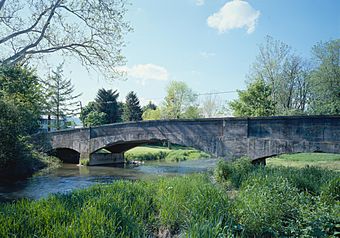Bridge in Metal Township facts for kids
Quick facts for kids |
|
|
Bridge in Metal Township
|
|

Bridge in Metal Township, May 2003
|
|
| Location | SR 4006 (Legislative Route 45 Spur) (Stone Bridge Road) over West Branch Conococheague Creek, near Willow Hill, Metal Township, Pennsylvania |
|---|---|
| Area | less than one acre |
| Built | 1907 |
| Built by | Nelson Construction Co. |
| Architectural style | Camelback-shaped arch |
| MPS | Highway Bridges Owned by the Commonwealth of Pennsylvania, Department of Transportation TR |
| NRHP reference No. | 88000763 |
| Added to NRHP | June 22, 1988 |
The Bridge in Metal Township, also known as Keggereis Ford Bridge, is an old and important bridge in Metal Township, Pennsylvania. It helps Stone Bridge Road (State Route 4006) cross over the West Branch Conococheague Creek. This bridge is special because it's listed on the National Register of Historic Places, which means it's an important part of history!
Contents
The Bridge in Metal Township
This historic bridge is located in Franklin County, Pennsylvania. It's a concrete arch bridge, which means it uses curved supports to hold up the road. The bridge is quite long, measuring about 105 feet (32 meters) in total.
What Kind of Bridge Is It?
The Bridge in Metal Township has three main sections, called spans. The longest of these spans is about 45 feet (13.7 meters) long. Its design is known as a "Camelback-shaped arch." This means the top of the bridge has a gentle curve, similar to a camel's hump. It's a strong and classic way to build bridges.
When Was It Built?
This bridge was built a long time ago, in 1907. That makes it over 100 years old! The company that built it was called Nelson Construction Co. They did a great job, as the bridge is still standing and being used today.
Why Is This Bridge Special?
The Bridge in Metal Township is considered very important because of its age and how it was built. Because of its historical value, it was officially added to the National Register of Historic Places on June 22, 1988. This list includes places across the United States that are worth preserving for future generations. It helps people remember and learn about the past.



